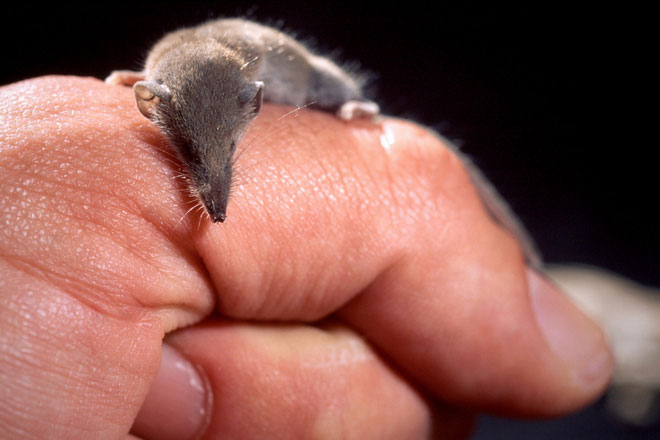The brain is one of the most powerful and metabolic organs in the body. These two attributes determine that the structure and function of the brain must constantly adapt to changes in the metabolic level of the body in order to improve the chances of survival of animals. Common changes include seasonal hibernation and migration and mating.
The Dehnel phenomenon (Dehnel phenomenon) is the most surprising phenomenon among them. In the harsh winter environment, the shrew’s brain has undergone a change that surprises the scientific community.
Robert Naumann, a researcher at the Institute of Brain Awareness and Brain Diseases, Shenzhen Institute of High Technology, Chinese Academy of Sciences, led a research group and, with scientists from Germany and Israel, conducted specialized research. Deep into the brain structure of the Suncus etruscus shrew.
This seasonal change in the animal’s brain explains the experimental phenomenon whereby nerve cells in the cerebral cortex are inhibited by tactile signals in winter.
The research results were recently published in the Proceedings of the National Academy of Sciences of the United States and selected for the cover page.

It is the smallest mammal in the world by body weight.
Found from the Mediterranean to Malaysia, the Suncus etruscus shrew only has a body length of 36mm to 53mm, excluding the tail. It is the smallest mammal in the world when measured by body weight, averaging just 1.8g.
Suncus etruscus is the smallest land mammal with a weight of only 2 grams, they are distributed mainly in the subtropical and temperate regions of Eurasia, from 10 to 40 degrees north latitude. Their small size resulted in a high metabolic rate and an inability to store energy like other animals.
In order to adapt to an active nocturnal habitat, this shrew has evolved to be able to hibernate during the day and form the Dehnel phenomenon in winter.
To explore the Dehnel phenomenon, the team used nuclear magnetic resonance, in situ hybridization, and other technologies to track general anatomy at the cellular level, from behavioral tracking to activity. cortical neurons and clarifying changes in the structure of their cortical neurons in winter and summer.
Members of the team have long followed many brain structures of the Suncus etruscus shrew using MRI and found that the cerebral cortex is the most important structure of the phenomenon. The cortex of the Suncus etruscus shrew is about 10% less in winter than in summer.
Due to the poor vision of the Suncus etruscus shrew, they mainly locate prey through its very sensitive beard. Preliminary research shows that the Suncus etruscus shrew is a master hunter, taking only a few hundred milliseconds to be able to kill its prey after bringing it into view.
Based on the above phenomenon, the team focused on the somatosensory cortex of this species of mouse. The team found that the fourth layer of nerve cells in the somatosensory cortex of this species have the greatest metabolic need for energy and will decrease by 28% in winter thickness, while the thickness of the layers. the other child does not have a significant change.
In the fourth layer of the cerebral cortex there is an intermediate nerve cell Parvalbumin (PV nerve cell), the main function of this type of nerve cell is to inhibit the activity of peripheral nerve cells. According to the process of staining the brain slices, the number of PV neurons in this animal in winter will be lower than in summer, which provided supporting anatomical data for the study results.
The Suncus etruscus shrew locates its prey thanks to its very sensitive beard.
This rat is constantly looking for food to keep its body warm. Once there is not enough food, it will be cold and fall into a state of hibernation, in which case the body temperature will drop to around 12 degrees Celsius.
The response of nerve cells to tactile signals can be divided into three categories: activated, inhibited, or unresponsive. Through experiments, the team continuously studied rat beards and recorded calcium signaling from cortical neurons and quantified the nerve’s response to tactile stimulation. .
Comparing the fall and winter experiences with those of spring and summer, the team found that in winter, the shrew had multiple neurons activated by signaling. more tactile effect. It is consistent with anatomical data showing that PV nerve cells increase in spring and summer. The proportion of intracellular neurons inhibited by tactile stimuli increases 2-3 times in autumn and winter.
When fully fed, this rat enjoys hunting crickets and worms. But when food is scarce, they hunt beetles to alleviate their hunger.
This study filled the gaps in the study of seasonal variations in the nervous system of animals. Through long-term follow-up of individual individuals and year-over-year recording of animals in the group, it reveals differences in the animal’s cerebral cortex at the cellular, physiological, and anatomical levels. general.
At the same time, this long-term adaptive alteration of the nervous system can also be seen as a manifestation of nervous endurance.


